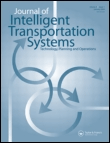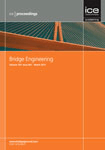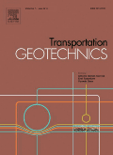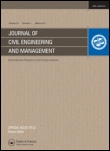
Baltic Journal of Road and Bridge Engineering
Scope & Guideline
Elevating Standards in Road and Bridge Engineering Research
Introduction
Aims and Scopes
- Transportation Infrastructure Engineering:
The journal emphasizes research on the design, construction, and maintenance of transportation infrastructures, including roads and bridges, focusing on innovative materials and methods. - Traffic Safety and Management:
A significant area of focus is on enhancing road safety through research on traffic management systems, accident analysis, and the impact of human factors on road safety. - Sustainable Practices in Road Construction:
The journal promotes studies that explore sustainable materials and practices in road construction, including the use of recycled materials and environmentally friendly technologies. - Performance Evaluation and Modeling:
Research on the performance evaluation of various pavement materials and structures, utilizing both experimental and numerical modeling approaches to predict behavior under different conditions. - Impact of Technology on Transportation:
The journal covers the integration of technology in transportation, including the use of machine learning, sensors, and smart systems to improve infrastructure performance and safety.
Trending and Emerging
- Smart Transportation Systems:
There is a growing emphasis on the integration of smart technologies in transportation, including data-driven approaches to improve traffic management and infrastructure monitoring. - Sustainable and Green Materials:
Research is increasingly focusing on the use of sustainable materials, such as recycled asphalt and innovative composites, to reduce the environmental impact of road construction. - Human Factors in Road Safety:
Emerging studies are exploring the psychological and behavioral aspects affecting road safety, including driver behavior, distraction, and pedestrian safety, reflecting a holistic approach to safety. - Climate Resilience in Infrastructure:
With the increasing impact of climate change, there is a rising interest in studies that assess and enhance the resilience of transportation infrastructures against extreme weather events. - Advanced Computational Techniques:
The use of advanced computational methods such as machine learning and simulation modeling is trending, especially in predicting pavement performance and assessing traffic dynamics.
Declining or Waning
- Traditional Material Studies:
Research focusing solely on traditional materials such as standard asphalt and concrete without innovative modifications or sustainability considerations has decreased, as the field shifts towards advanced materials. - Basic Structural Analysis:
Studies that concentrate primarily on basic structural analysis without incorporating modern computational methods or addressing complex loading scenarios are becoming less common. - Historical Infrastructure Studies:
There has been a noticeable reduction in papers solely dedicated to historical infrastructure assessments, as contemporary issues and innovations take precedence in research priorities. - Static Traffic Flow Analysis:
The focus on static models of traffic flow has waned, with researchers increasingly gravitating towards dynamic and real-time traffic analyses that incorporate modern data collection and processing technologies. - Conventional Safety Measures:
Research on conventional safety measures is declining in favor of studies that explore innovative safety technologies and behavioral analyses related to traffic incidents.
Similar Journals

Jordan Journal of Civil Engineering
Pioneering Insights for Structural ExcellenceThe Jordan Journal of Civil Engineering, ISSN 1993-0461 and E-ISSN 2225-157X, serves as a pivotal platform for research dissemination in the field of civil engineering. Published by Jordan University of Science & Technology, this journal has established itself as a vital resource since its inception in 2007 and continues to impact the academic community with its wide-ranging scope covering innovative practices and cutting-edge research in civil and structural engineering. Holding a respectable Q3 ranking in the 2023 category, with Scopus positioning it at rank #235 out of 379, the journal reflects growing recognition within its discipline. Although currently not an open-access publication, it provides essential insights that can benefit researchers, industry professionals, and students seeking to contribute to advancements in civil engineering through rigorous scholarly articles and studies up to 2024. Its commitment to high academic standards enhances the relevance and importance of its contributions to both local and global engineering practices.

Civil and Environmental Engineering
Empowering scholars to build a sustainable tomorrow.Civil and Environmental Engineering, published by SCIENDO, is a prominent open-access journal dedicated to advancing research and knowledge in the fields of civil and structural engineering, as well as environmental engineering. Since its inception in Germany, it has been committed to promoting cutting-edge studies and methodologies that address the pressing challenges in these domains. With an ISSN of 1336-5835 and E-ISSN of 2199-6512, the journal is accessible to a global audience, having adopted an open-access policy since 2014 to enhance the visibility and dissemination of scholarly work. The journal currently holds a Q3 ranking in both Civil and Structural Engineering and Environmental Engineering, as of 2023, reflecting its growing influence within the academic community. It operates within a framework of rigorous peer-review standards and encourages contributions that not only contribute to theoretical advancements but also have practical implications for real-world applications. Researchers, professionals, and students alike will find invaluable insights and innovative perspectives in the latest studies published from 2018 to 2024.

Journal of Intelligent Transportation Systems
Innovating Transportation Systems for a Sustainable TomorrowThe Journal of Intelligent Transportation Systems is a premier peer-reviewed journal published by Taylor & Francis Inc, focusing on cutting-edge research in the fields of transportation systems and intelligent technologies. With an ISSN of 1547-2450 and an E-ISSN of 1547-2442, this journal stands out with its impressive impact, consistently ranking in the Q1 Quartile across multiple categories such as Aerospace Engineering, Applied Mathematics, and Automotive Engineering, among others. As of 2023, it holds distinguished Scopus rankings, including a remarkable #11 position in Aerospace Engineering, showcasing its significance in shaping contemporary research in intelligent transportation. Targeted at researchers, professionals, and students alike, the journal provides a forum for the dissemination of innovative ideas and technologies that enhance transportation systems’ efficiency, safety, and sustainability. The Journal of Intelligent Transportation Systems has been operating since 2004 and continues to play a vital role in advancing knowledge within its respective areas of study within the United Kingdom and globally.

Proceedings of the Institution of Civil Engineers-Bridge Engineering
Unveiling Insights in Bridge Development and MaintenanceProceedings of the Institution of Civil Engineers - Bridge Engineering, published by Emerald Group Publishing Ltd, is a pivotal academic journal that delves into the essential and dynamic field of bridge engineering and design. With an ISSN of 1478-4637 and an E-ISSN of 1751-7664, this journal serves as a vital resource for researchers, professionals, and students seeking to expand their knowledge and stay updated with the latest advancements and innovations in civil and structural engineering. The journal has demonstrated its relevance in the academic community with a current Scopus ranking of 101/223 in Engineering - Building and Construction and 193/379 in Engineering - Civil and Structural Engineering, both placing it in the Q3 quartile category. Despite its traditional publishing format, the journal remains a key platform for high-quality research from 2004 to 2024, especially for those interested in the intricacies of bridge development, maintenance, and sustainability. Ultimately, Proceedings of the Institution of Civil Engineers - Bridge Engineering aims to bridge the gap between theoretical knowledge and practical application, driving innovation and excellence in the realm of civil engineering.

Transportation Safety and Environment
Innovating solutions for sustainable transportation practices.Transportation Safety and Environment is an esteemed open-access journal published by Oxford University Press, dedicated to advancing the field of transportation safety and environmental sustainability. Since its inception in 2019, the journal has rapidly gained recognition with an impressive Q2 category ranking in Control and Systems Engineering, Engineering (miscellaneous), and Safety, Risk, Reliability and Quality as of 2023. With an E-ISSN of 2631-4428, it provides a platform for high-quality research that addresses critical safety challenges and environmental impact within the transportation sector, covering a wide array of topics from vehicle safety measures to ecological considerations in transportation infrastructure. The journal’s open-access model promotes widespread distribution and accessibility of research findings, enabling researchers, professionals, and students to engage with the latest advancements and contribute to future developments in the field. Located in the heart of the United Kingdom at Great Clarendon St, Oxford OX2 6DP, England, Transportation Safety and Environment stands at the forefront of fostering innovative solutions for safer and more sustainable transportation practices worldwide.

Journal of Road Safety-JRS
Enhancing road safety through open dialogue.Journal of Road Safety (JRS) is a premier open-access journal published by the Australasian College of Road Safety, dedicated to advancing the field of road safety research and knowledge dissemination. With its establishment in 2019, JRS aims to bridge the gap between academic research and practical applications to enhance road safety outcomes across diverse populations. The journal is committed to publishing high-quality, peer-reviewed articles that contribute to the understanding of safety measures, risk assessment, and transportation reliability. Notably, it holds a significant presence in its category quartiles, ranking Q3 in Safety Research, Safety, Risk, Reliability and Quality, Social Sciences, and Transportation for 2023, indicating its emerging influence in these vital areas. With an ongoing open-access model since 2020, JRS ensures that its valuable research findings are freely available to researchers, professionals, and students alike, thus fostering a global dialogue on best practices and innovations in road safety. The journal is recognized in Scopus rankings, highlighting its role in enhancing the visibility and impact of its published works within the broader scientific community.

Transportation Geotechnics
Pioneering Insights for Sustainable Transport Systems.Transportation Geotechnics is a premier academic journal published by Elsevier, focusing on the intersection of geotechnical engineering and transportation systems. With an impressive impact factor and categorized in the Q1 quartile across multiple disciplines including Civil and Structural Engineering, Geotechnical Engineering, and Transportation, this journal stands as a vital resource for researchers and practitioners alike. It covers a broad spectrum of topics ranging from soil behavior in transport contexts to innovative materials and methods that enhance infrastructure stability and performance. As an essential platform fostering knowledge dissemination, Transportation Geotechnics enables contributors to share their groundbreaking findings while providing readers with access to cutting-edge research and reviews from 2014 to 2024. Its illustrious Scopus rankings place it prominently in the global research landscape, making it an indispensable tool for students, professionals, and academics dedicated to advancing the field.

Journal of Civil Engineering and Management
Innovating the future of construction and strategic leadership.Journal of Civil Engineering and Management, published by Vilnius Gediminas Technical University in Lithuania, is a prominent open access journal dedicated to the dissemination of cutting-edge research in both civil and structural engineering as well as strategic management. With the ISSN 1392-3730 and E-ISSN 1822-3605, this journal has been an essential resource for academics and industry professionals since its inception in 2002 and has continued through to 2024. Recognized for its high-quality publications, it ranks in the Q2 quartile in both the fields of Civil and Structural Engineering and Strategy and Management, reflecting its significant impact in the academic community with a Scopus ranking of #75 out of 379 and #121 out of 478 respectively. The journal embraces an open-access model, promoting wider distribution and accessibility of knowledge to foster innovation and collaborative advancements in construction practices and management strategies. It serves as a vital platform for researchers, professionals, and students looking to contribute to and stay informed about the latest developments in these dynamic fields.

Teknik Dergi
Advancing the Frontiers of Civil EngineeringTeknik Dergi is a key academic journal published by the Turkish Chamber of Civil Engineers, focusing on the critical fields of Building and Construction as well as Civil and Structural Engineering. Established in Turkey, this journal serves as a vital platform for researchers, practitioners, and students to disseminate innovative findings and advancements within these disciplines. Although its coverage in databases like Scopus has been discontinued since 2022, Teknik Dergi remains a respected resource for its historical contributions, with a record of publication spanning from 1990 to 1998 and then from 2002 to 2022. The journal currently holds a Q4 categorization in both its primary fields, ranking within the 30th and 25th percentiles respectively. Authors and readers can access articles exploring practical applications and theoretical foundations, making it a valuable asset for those engaged in the rapidly evolving landscape of civil engineering. Open Access options are also available, allowing for broader dissemination and engagement with its published work.

Civil Engineering Journal-Stavebni Obzor
Advancing Civil Engineering Knowledge for a Global AudienceWelcome to the Civil Engineering Journal-Stavebni Obzor, an esteemed academic publication dedicated to advancing the field of civil engineering. Published by the Czech Technical University in Prague, Faculty of Civil Engineering, this journal has provided a platform for innovative research and critical discourse since its inception. With an ISSN of 1210-4027 and an E-ISSN of 1805-2576, this Open Access journal has been facilitating wide dissemination of knowledge in civil engineering since 2014, ensuring that valuable research reaches a global audience without barriers. The journal is committed to fostering collaboration among researchers, professionals, and students, encouraging the exchange of ideas that drive the discipline forward. Its diverse scope encompasses various aspects of civil engineering, making it an essential resource for anyone looking to stay at the forefront of this dynamic field. Located in Prague, a hub of engineering excellence, this journal not only reflects the latest trends and innovations but also contributes to shaping the future of civil engineering.